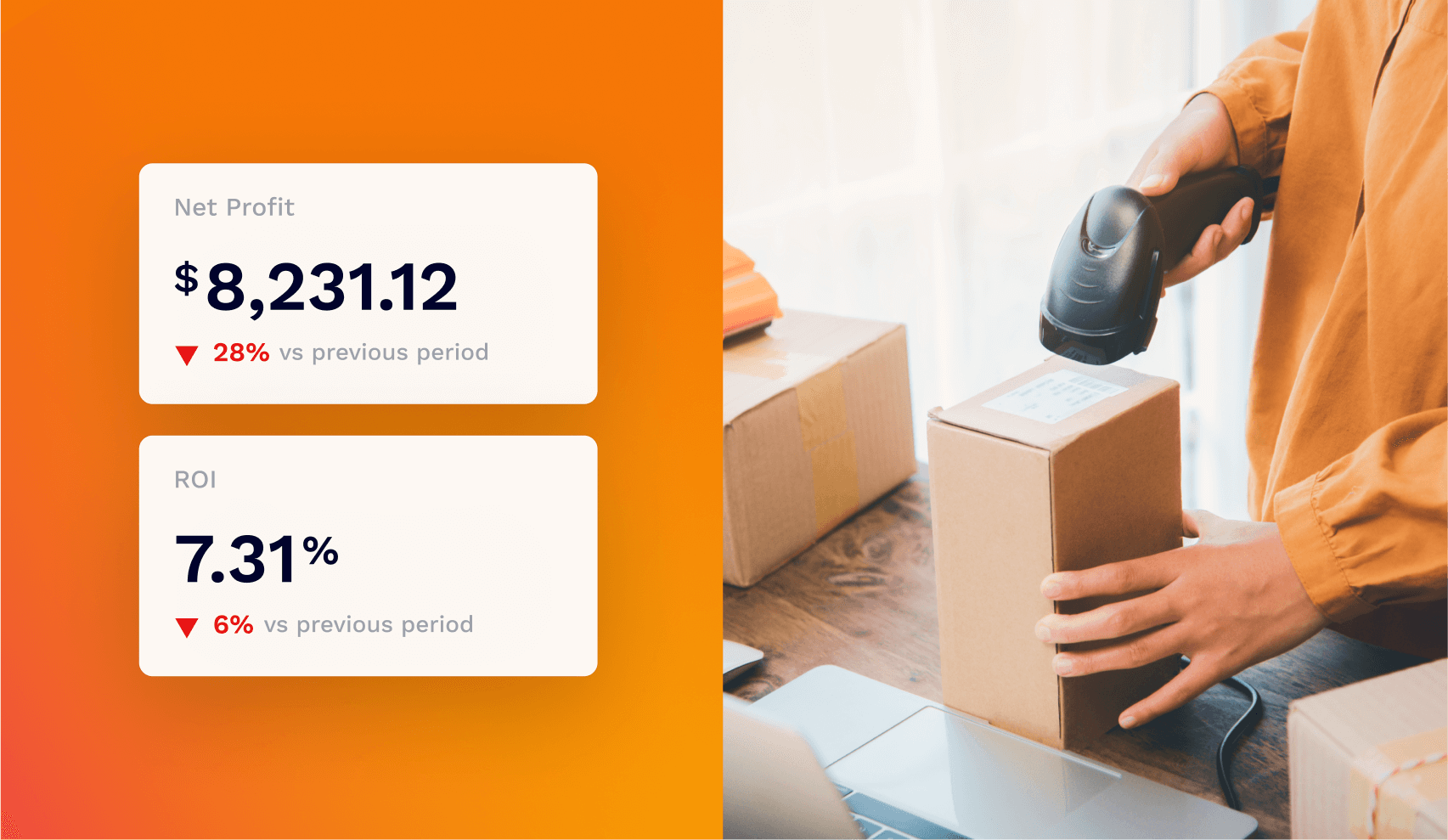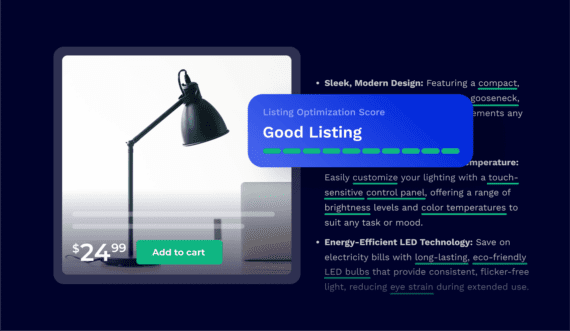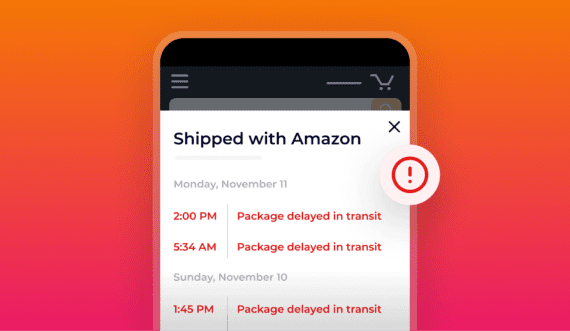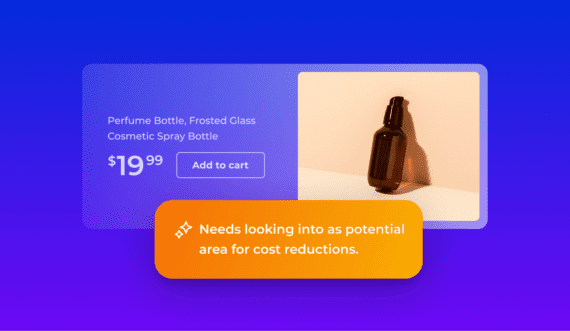If you sell on Amazon, you know the size and scale of the opportunity that the ecommerce giant provides. For many entrepreneurs and established ecommerce businesses alike, selling on Amazon is a vital part of growing a profitable business.
But even though the opportunities are nearly endless, selling on Amazon has its challenges. High on the list is maintaining sustained, long-term profitability.
There are millions of sellers competing for attention and market share. Sellers encounter fees and surcharges they might not have expected. And there’s constant price pressure as sellers compete to be seen as the most affordable option.
Through it all, businesses and brands must keep their eye on the prize: profit.
This guide will walk you through why Amazon sellers deal with profitability challenges and provide actionable solutions to maximize your profits.
Are profitability challenges an issue for Amazon sellers at all levels?
The truth is, yes.
While it’s certainly possible to make money on Amazon, most ecommerce sellers on Amazon marketplace will encounter profitability challenges along the way. They affect sellers at all levels, including both new and well-established Amazon businesses.
The challenges do tend to change as a seller gains experience, though. New sellers face hurdles like managing startup costs and cash flow and achieving critical mass (which includes gathering customer reviews, finding and launching successful products, optimizing listings, and attaining initial, sustainable profitability).
Experienced sellers, on the other hand, face struggles related to scalability and profit margins. In addition to managing a growing market share, they have to account for PPC advertising costs, stay on top of sourcing, suppliers, and inventory, and develop a cohesive business brand.
Amazon FBA sellers
Sellers who use Amazon’s Fulfillment by Amazon (FBA) program enjoy a high degree of convenience and less hands-on effort. They don’t have to worry about packaging, inventory storage, or the fulfillment side of the customer experience.
But premium fulfillment services like FBA come at a cost, leading some sellers to wonder whether selling through Amazon FBA is still worth it.
We say it certainly can be, but FBA sellers should be prepared for high fulfillment fees and storage costs. There’s also added complexity and costs for managing returns. Sellers in Amazon product categories like Clothing & Shoes, Jewelry, and Electronics may encounter greater profitability challenges due to the naturally higher return rates of these categories.
So, while FBA provides convenience, you’ll need to account for these added costs and manage them proactively.
Amazon FBM sellers
The other option is Fulfillment by Merchant (FBM). This is the DIY approach, where the seller pays Amazon much less but bears the burden of shipping, handling, and inventory management.
FBM sellers retain greater control over their fulfillment processes, which can be both a blessing and a curse. They can inject a higher level of customer service and responsiveness, but they’re also on the hook for anything that goes wrong.
Taking the FBM approach can lower some costs, but maintaining profitability requires efficient, scalable processes.
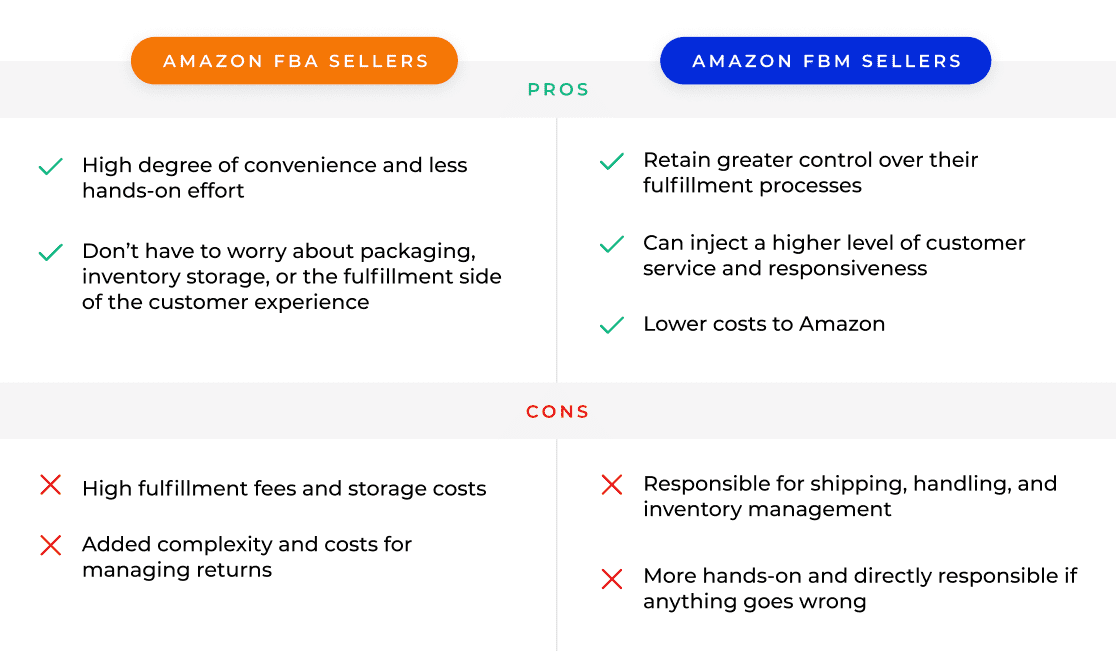
Common profitability challenges for Amazon sellers
Let’s dig a little deeper into some of the most common profitability challenges for Amazon sellers of all sizes and types.
Amazon fees and unexpected costs
Even the most inexperienced seller can probably guess that selling on Amazon isn’t free. But exactly how, where, when, and how much Amazon takes can feel a little more mysterious. Here’s a quick breakdown of the fees Amazon charges third-party sellers:
- Referral fees: This is Amazon’s “cut” or commission — the percentage of your sales price that Amazon deducts from your seller account after the sale. These range from 8–45%, depending on the product category.
- Per-item or subscription fees: Professional sellers pay $39.99 per month to sell on the platform, while individuals pay $0.99 per transaction. Like referral fees, these are taken from your seller account, not upfront.
- Refund administration fees: Amazon-issued refunds cost you $5 or 20% of the refunded charge, whichever is less.
- FBA fulfillment fees: These are the fees FBA sellers pay for Amazon to handle fulfillment (including shipping). They range from $3.06 to $6.81 for most items up to three pounds.
- FBA storage fees: FBA sellers pay either monthly or long-term storage fees for items sitting in Amazon’s fulfillment centers. (These rates are quite complex — see our full guide to Amazon FBA fees for more details.)
- Other miscellaneous fees: FBA sellers may also incur low-level inventory fees and inbound placement service fees.
Thousands of sellers navigate these fees successfully and maintain profitability. But failing to account for these hidden and not-so-hidden costs can reduce or even destroy profitability.
Pricing pressure and competition
Pricing pressure is a common challenge across the entire retail industry. But it can be more pronounced on Amazon, where thousands of sellers with similar items could be competing for their slice of an astounding 2.7 billion monthly visitors. There’s often an immense pressure to offer lower prices, which could thin out your profit margins considerably.
Price wars are not unheard of, and then there’s the 50-million-pound elephant in the room: Amazon itself might jump into your product category with a good-enough Amazon Basics version, putting downward pressure on your prices.

Inventory management issues
Sellers who don’t maintain tight control of their inventory may incur extra fees or lose sales opportunities. FBA sellers must pay higher fees if they have too much or too little of a product in Amazon’s fulfillment centers.
In addition, overstocks tie up your assets in merchandise that isn’t going to sell anytime soon, and stockouts completely eliminate your ability to compete on the item you’re out of.
Customer complaints and returns
Customer behavior after the sale can hurt your profits, too. Unhappy customers may leave poor reviews, which hurt your search rankings, lower your conversion rates, and drag down profitability. Then you may have to invest more money to shore up whatever issue with your product(s) led to the complaints.

Returns are also a real concern. They cost you money and add to your administrative burden. Some returns are inevitable, but it’s a good idea to make adjustments to product listings where possible to reduce confusion and lower your return rates.
Get insights from successful Amazon sellers on profitability, advertising investments, and more.
Strategies to help Amazon sellers improve their profit margins
Despite the challenges to profitability we’ve covered, it’s possible to make a healthy profit on Amazon — and here’s how:
Use data to monitor profits, Amazon fees, and additional costs
First, make sure you understand your true level of profit, accounting for all costs and fees. Only then can you compare your success against the average Amazon seller profit margins.
You’ll need software tools like Jungle Scout’s Sales Analytics to track these metrics. Jungle Scout helps you track units sold, Amazon fees, account health, and more, so you can keep a close eye on revenue and profit margins all the way down to the individual product level.
With this level of data granularity, you can quickly identify profitability issues and adjust your strategies and pricing accordingly.
Established sellers can also benefit from cutting-edge AI Assist tools in Jungle Scout’s Review Analysis, Profit Overview, and Listing Builder features. The Review Analysis tool is particularly valuable here, helping you identify common issues and themes in seller reviews.

You can use this knowledge to shore up weaknesses with products, listings, and pricing, which feeds back into the data you’re collecting to monitor overall profitability.
Optimize your Amazon pricing structures
Sellers face rapidly changing prices, new Amazon sellers, and competing new products every single day. So private label sellers often have to optimize their pricing structures continuously to adapt to these changes.
Repricing tools are a useful way to automatically adjust prices within boundaries you set based on competitor activity. With these, you can maintain profitable margins while avoiding missing out on sales due to noncompetitive pricing.
Jungle Scout’s Competitive Intelligence is another valuable tool that helps sellers gain insights into competitors’ pricing strategies and optimize their own pricing accordingly.
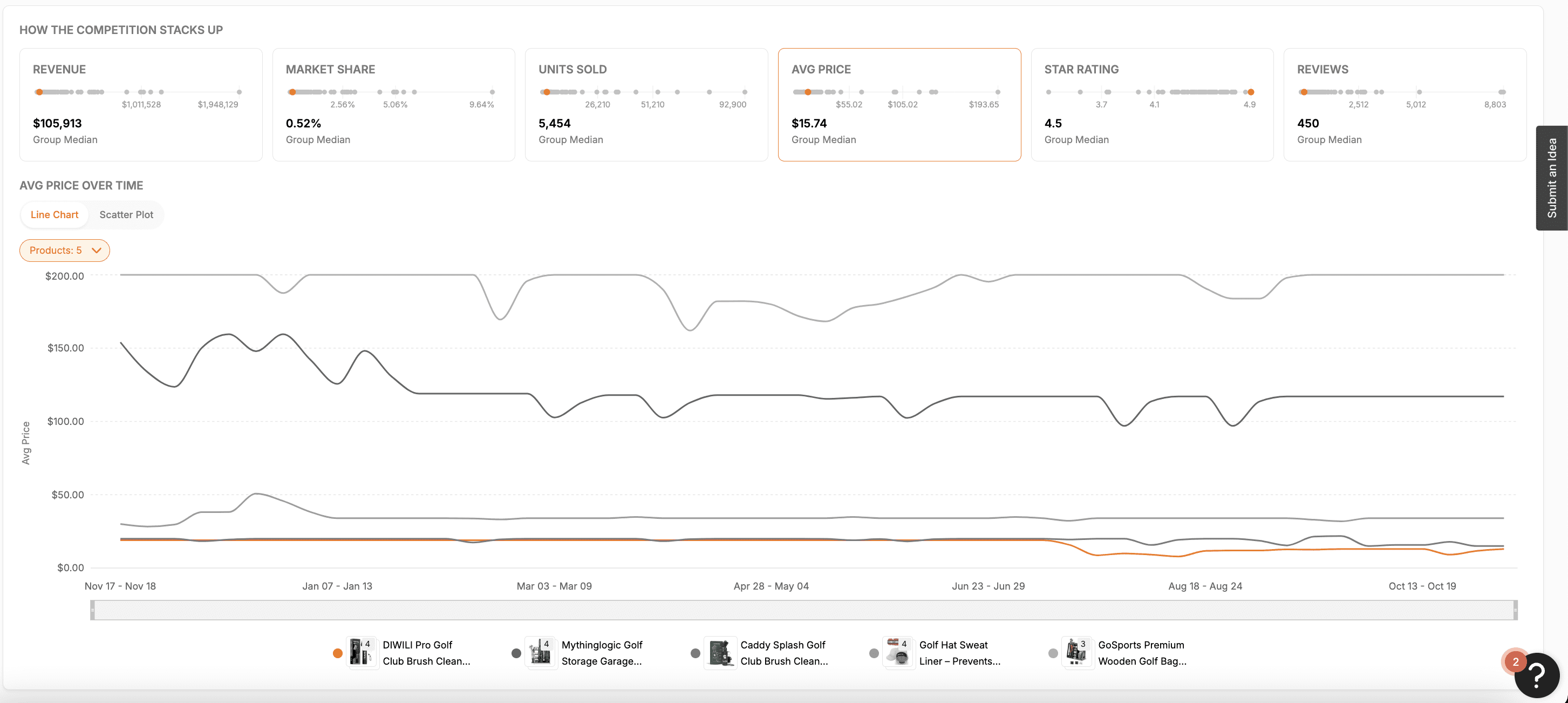
And finally, there’s dynamic pricing models. These enable sellers to adjust prices based on factors like seasonal demand, competitor pricing, and stock levels.
It’s tempting to “optimize” your pricing all the way to the bottom of the competitor pool, but we find this usually squeezes profits too hard. Most sellers who significantly undercut the rest don’t last long, so holding the line on your profit margin is a good long-term strategy.
Speaking of the race to the bottom, this is also easier to avoid if your product is differentiated in some way from the generic version of the item.
Forecast demand and streamline inventory management
Effective inventory management would be easy if demand were a flat line or a steadily increasing angle, but that isn’t how retail works for most products. Most of the time, you’ll also need to predict future demand with some level of accuracy if you want to keep your inventory levels healthy.
Again, you’ll need software tools to do this well and scale your demand forecasting processes. Jungle Scout offers a powerful Inventory Manager that helps you understand demand, set and keep optimal stock levels, and minimize fees.
With tools like Inventory Manager, Competitive Intelligence, and Sales Analytics, we think the value is clear: Jungle Scout is well worth it for Amazon FBA sellers.
Improve product quality and reduce returns
Our final strategy for improving profit margins may cost you upfront, but the payoff makes this investment worthwhile.
We’re talking about improving quality, both of the products you sell and the way you present them. It’s wise to focus on selling quality products, but it’s just as important to present them effectively using high-quality photos, copy, and videos. You want your products and their pages to be irresistibly attractive to your prospective customers — and to Amazon’s search algorithms.
Remember, Amazon wants to show shoppers the things that they will ultimately buy, keep, and be satisfied with. The closer your items get to being the best option for a given search, the higher your product visibility should be.
Plus, when your products are higher in quality (and your listings thoroughly describe your products), you’ll tend to see lower return rates — and lower return rates will further improve profitability.
Why? Because when people open up that box and see a high-quality product that looks and functions exactly like they thought it would, there’s no reason to return it.
How can you improve quality and reduce return rates? Here are a few best practices:
- Invest in quality control measures during production and fulfillment. This is a great way to reduce the number of defective products produced and shipped out to customers.
- Create high-quality media and content for your product pages. Can customers see every angle, facet, and feature in product photos? What about video? Is your copy clear, engaging, and persuasive?
- Proactively monitor customer feedback. Address issues quickly to prevent negative reviews and high return rates.
- Use customer insights from Jungle Scout’s tools to refine product features that align with customer expectations. If you’re consistently getting complaints about an element, change it. If you’re consistently getting praise for one, then feature it in the listing.
- Conduct careful product research. Part of reducing return rates is understanding what products customers want, along with what features they want in those products.
Ready to maximize your profit margins? See how Jungle Scout can help
Maximizing profit margins as an Amazon seller takes the right products, prices, and tactics — not to mention the right tools.
There are plenty of challenges that threaten to eat into your profit margins, including Amazon’s fees, competitor products and pricing, high return rates, and inventory management issues.
And Jungle Scout can help with all of the above.
Jungle Scout is the suite of data-driven tools your Amazon business needs to understand products and customers, optimize listings, calculate and improve profits, manage inventory, and much more. We help sellers of all sizes enhance their approach to selling on Amazon so they can grow their businesses sustainably — and profitably.
